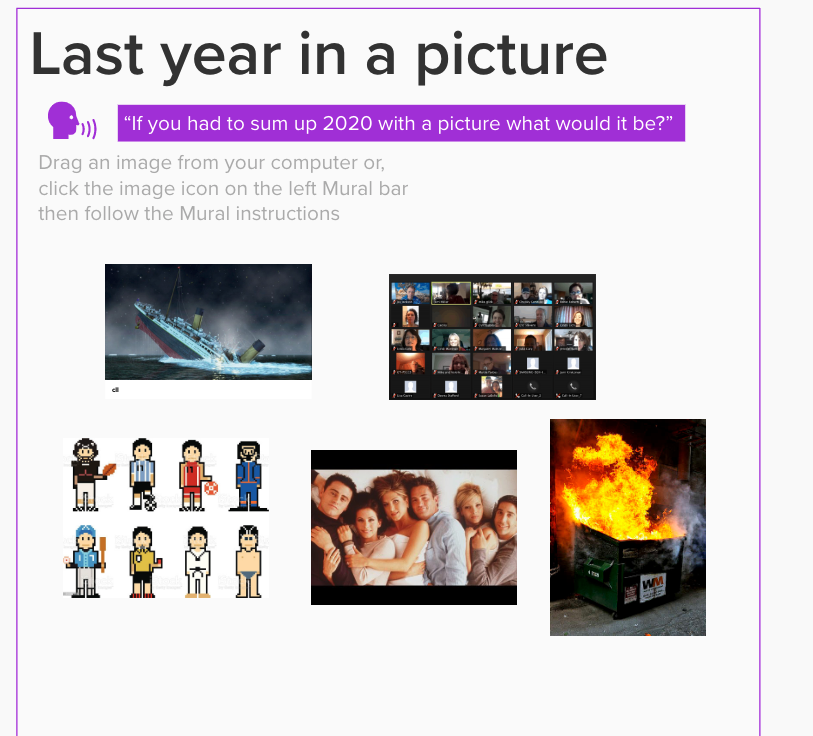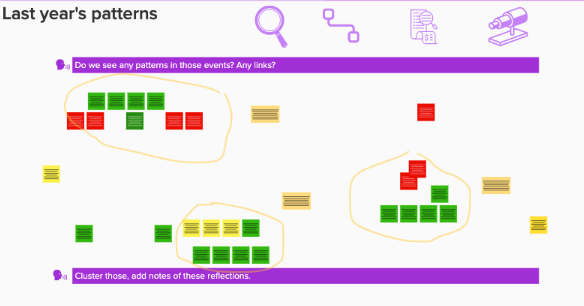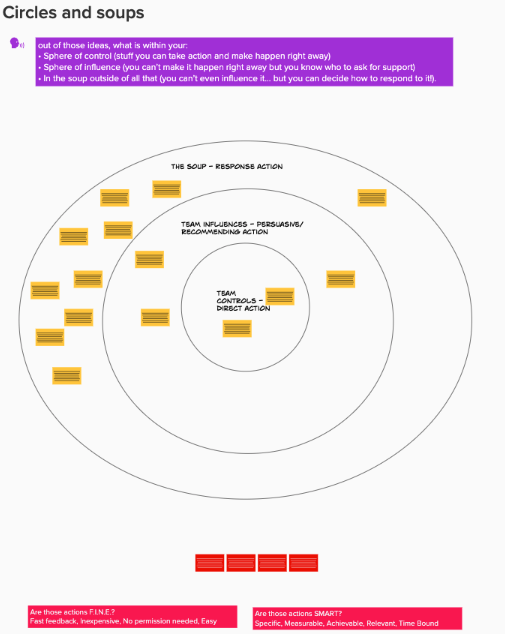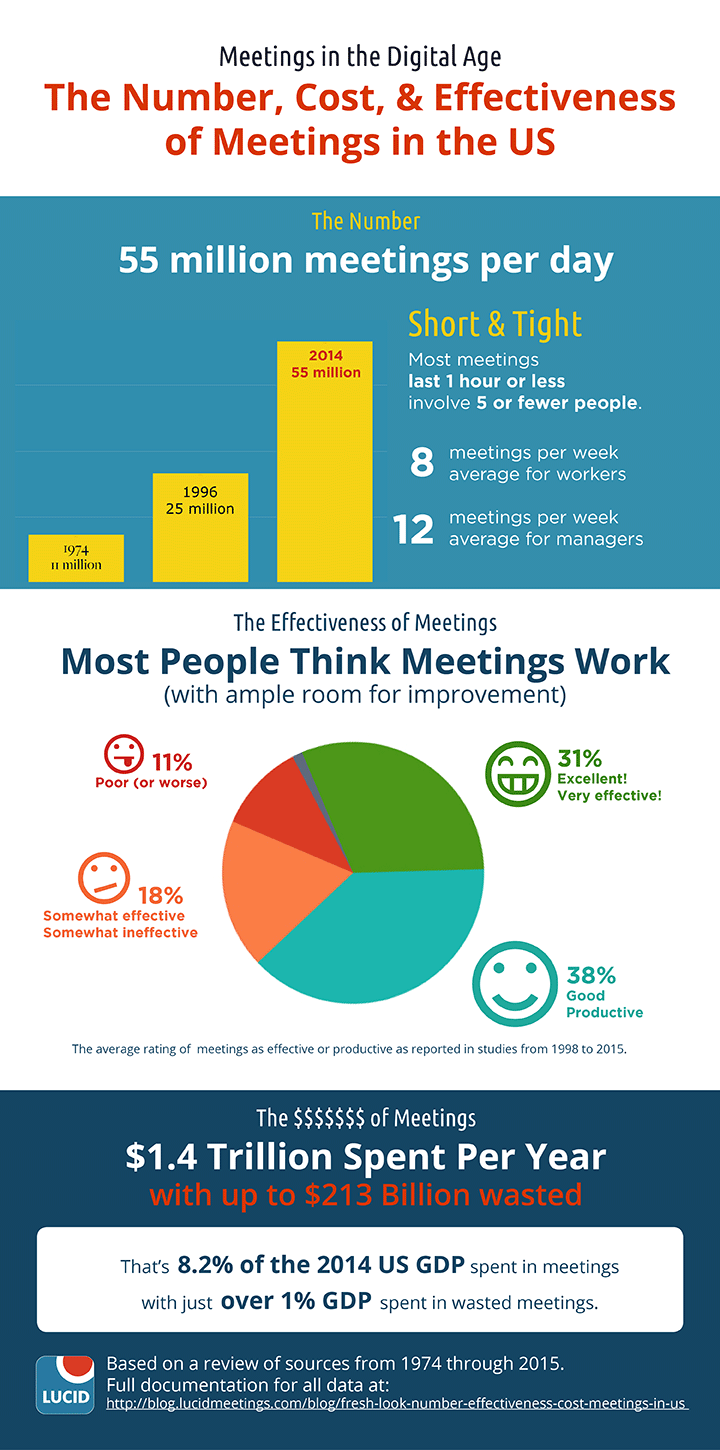Hindsight is 2020: How to Run a Year-in-Review Team Retrospective
What happened? So what does that mean? Now what should we do going forward?
In a retrospective meeting, you and your team work to answer these three questions together. When you’re reviewing a short event that just happened, your retrospective meeting might be very short as you all simply work to answer these questions directly.
When you’re looking at something as long as a year or something involving lots of complex interrelated parts, it doesn’t work to just ask “So, what happened in 2020?” That’s more likely to encourage day drinking than useful insights.
For something as 2020 as 2020, you’ll need to put a bit more structure in place if you want a useful result.

Introducing Enrico Teotti
That’s why we’re thrilled to introduce you all to Enrico Teotti. Enrico hosts the This is Retrospective Facilitation podcast and is an active leader in the agile facilitation and coaching community.
As his holiday gift to us all, Enrico put together a meeting template we can use to try and make some useful sense out of 2020 with our teams. Check it out!
~ Team Lucid
Running an End-of-Year Retrospective
How was your year?
In this short post I’ll describe one way to run an annual retrospective so you and your group can reflect on what happened this past year, discuss what you make of it, and begin to decide what the next wise actions to take next year might be.
About this Retrospective
Purpose
Use this meeting to reflect on what happened this past year, what you make of it, and what your next wise action will be to influence next year. This can be in a work context or family context.
Why? Experience + Reflection = Learning.
When you skip the reflection, you run the risk of making lots of dumb mistakes because you failed to capture and apply the learning from your own experiences.
Like all retrospectives, this meeting will help ensure your group actually learns something from the remarkable experiences in 2020.
Intended outcomes
- A shared perspective on what happened
- Awareness of recurring patterns, both healthy and counterproductive
- Understanding of links between cause and effect
- One or two ideas for experiments to try in the next year
Expected Duration: 90 minutes if you work to keep discussion focused.
Because there’s so much to unpack here, you may want to reserve several hours to allow for more free-ranging discussion.
Before the Meeting
Setup
You will need a way for the group to share ideas in writing. If you are able to meet face-to-face, a whiteboard, sticky notes, and markers come in handy.
For those of you meeting remotely, you’ll need a videoconference service and a way to collaborate online. As an example, I’ve created a Mural template that supports this format in an online whiteboard. You’ll see screenshots from that below.
The Invitation and Prep Work
The first step in this retrospective involves looking back at the year to create a shared understanding of what just happened. This works best when your team prepares in advance.
Before the meeting, encourage your group to create a list of:
- useful business metrics
- milestone dates
- other significant business events in the past year
Ask them to also capture important personal events. For example:
- When did their kids start attending school from home?
- When were they personally impacted by Covid-19/wildfires/riots/crazy elections/shutdowns/ or otherwise mourn?
- When did they get married/earn a degree/move to a new home/welcome a child/release a new album with their band/ or otherwise celebrate?
During the meeting, you’ll build a shared timeline that combines all these business, personal, and world events onto a single timeline, then look to see which patterns and connections suddenly become clearer to everyone once you can see it all laid out together.
During the Meeting
Step 1: Why are we here?
10 to 15 minutes
The first step is to set the stage. Make sure the group knows the meeting purpose and intended outcomes. After that, create a connection between the group and the past year:
Ask the group:
“If you had to sum up this year with a single word what would it be?”
or if you have access to a tool that can share images:
“If you had to sum up this year with a picture what would it be?”

- give all a (timeboxed) chance to share with the group the reason for their choices
- ask for volunteers to share the reason for their choice
- choose a couple of words/images to elaborate.
Then, consider sharing Kerth’s Prime directive, a sentence that focuses the attention of the group on the context of the events rather than on blaming individuals. This is a critical step to make your Retrospective effective.
Kerth’s Prime Directive
“Regardless of what we discover, we understand and truly believe that everyone did the best job they could, given what they knew at the time, their skills and abilities, the resources available, and the situation at hand.”
~Norm Kerth, Project Retrospectives: A Handbook for Team Review
Sometimes we blame others (teams, political figures, countries), sometimes we blame ourselves. The bottom line is that blaming generates an unproductive loop. Instead let’s focus on the context and turn our judgement into curiosity. It’s not easy but remind the group of that.
Step 2: Looking at the Year
30 minutes or more
Now is the time to remember the year’s events by building a shared timeline.
In this year of worldwide pandemic, your events will be particularly entangled with international events. A lot of what influenced your group’s success this past year was outside of your direct control.
The sample Mural timeline includes a mix of international events to get you started.
A sampling of 2020 world events:
- Jan 1 – Australian bushfires
- Jan 20 – first confirmed case of 2019-nCoV infection in the United States (https://www.nejm.org/doi/full/10.1056/NEJMoa2001191)
- Jan 31 – Italy suspends flights to China and declares a national emergency after two cases are confirmed in Rome
- Feb 9 – Bong Joon Ho’s film “Parasite” wins Best Picture, Best Director, Best Original Screenplay and Best International Feature Film
- Feb 24 – Harvey Weinstein convicted
- Mar 9 – Italian nationwide lockdown (https://www.axios.com/italy-coronavirus-timeline-lockdown-deaths-cases-2adb0fc7-6ab5-4b7c-9a55-bc6897494dc6.html)
- Mar 11 – The World Health Organization declares the COVID-19 outbreak a pandemic
- Mar 17 – European leaders close the EU’s external and Schengen borders for at least 30 days in an effort to curb the COVID-19 pandemic
- Mar 30 – the Summer Olympics are rescheduled from July 23 to August 8, 2021
- Apr 1 – China reports 130 asymptomatic cases of COVID-19, its first reported asymptomatic cases
- Apr 2 – COVID-19 pandemic: The number of confirmed cases of COVID-19 passes 1 million worldwide
- Apr 5th – YouTube says it will remove videos promoting a conspiracy theory linking 5G to COVID-19
- Apr 8 – China ends the lockdown in Wuhan, with people allowed to leave the city for the first time in 76 days
- Apr 10 – The death toll from COVID-19 exceeds 100,000 globally, a ten-fold increase from March 20
- Apr 27 – The Pentagon formally releases three videos (previously leaked by Luis Elizondo in 2017) of “unidentified aerial phenomena” encountered by U.S. Navy pilots
- May 1 – COVID-19 pandemic: The total number of recovered COVID-19 patients reaches 1 million worldwide, according to data from The Johns Hopkins University
- May 23 – COVID-19 pandemic: China reports no new cases for the first time since the pandemic began, according to the National Health Commission
- May 26 – Protests caused by the killing of George Floyd break out across hundreds of cities in the U.S. and around the world.
- Jun 21 – An annular solar eclipse occur
- Jun 28 – The number of confirmed cases of COVID-19 passes 10 million worldwide
- Jun 30 – China passes the controversial Hong Kong national security law, allowing China to crack down on opposition to Beijing at home or abroad
- Jul 30 – NASA successfully launches its Mars 2020 rover mission to search for signs of ancient life and collect samples for return to Earth
- Aug 4 – An explosion caused by unsafely stored ammonium nitrate kills over 220 people, injures thousands, and severely damages the port in Beirut, Lebanon
- Aug 15 – The Japanese bulk carrier Wakashio breaks in half. Approximately 1,000 tonnes of oil are spilled into the ocean.
- Aug 25 – Africa is declared free of wild polio, the second virus to be eradicated from the continent since smallpox 40 years previously
- Sept 27 – Deadly clashes erupt in Nagorno-Karabakh between Armenian and Azerbaijani forces. Armenia, Azerbaijan, and the Republic of Artsakh introduce martial law and mobilize forces
- Oct 23 – At the end of an 11-year demining process, the Falkland Islands are declared free of land mines, 38 years after the end of the 1982 war.
- Nov 3 – 7 : 2020 United States presidential election: Joe Biden is elected as the 46th President of the United States, after remaining vote counts (November 7) come in from key states delayed by an influx of mail-in ballots caused by the pandemic, defeating the incumbent President Donald Trump.
- Nov 18 – COVID-19 pandemic: Pfizer and BioNTech complete trials on their COVID-19 vaccine, with an overall effectiveness rate of 95% without adverse events
- Nov 25 – COVID-19 pandemic: The number of confirmed cases of COVID-19 passes 60 million worldwide.
- Dec 8 – COVID-19 pandemic: The United Kingdom becomes the first nation to begin a mass inoculation campaign using a clinically authorised, fully tested vaccine
- Dec 18 – COVID-19 pandemic: The number of confirmed cases of COVID-19 passes 75 million worldwide
- Dec 21 – A great conjunction of Jupiter and Saturn occurs, with the two planets separated in the sky by 0.1 degrees. This was the closest conjunction between the two planets since 1623
Looking for more 2020 year-in-review inspiration? Check out JibJab’s quick video send-off for a look at the U.S. lowlights, and this lovely compilation of Things that Made Us Happy from our friends at Smith + Connors.
Invite your team to add the events they prepared before the meeting. Also, feel free to remove world events that aren’t relevant to your team.
Give everyone 5 to 10 minutes of a silent activity for the group to add their events to the timeline.
Then, with the full timeline in front of you, take turns drawing your “Peaks and Valleys.” Each person draws a line on the timeline showing where were the highs? Where were the lows?

Encourage each person to select a new color and use the drawing tool include in Mural or a marker to draw a line to highlight high and low points throughout the year.
This Peaks and Valleys exercise gives your team an efficient and illuminating way to see how all these events impacted your wellbeing.
Step 3: So what do we make of it?
20 minutes or more
After looking at the context (international and specific to the group) and seeing the objective (events) and reflective (feelings) portions, you can move on to deeper reflection.
Ask the group:
Do we see any patterns in these events? Any links?
Add notes about the insights the group reveals.

Then ask the group to silently brainstorm about the future. Make sure everyone has a way to write down their ideas, then prompt the group with:
Given where we are today and everything we’ve learned, what would make our 2021 the best year yet?
Set a timer for 3 minutes to generate ideas.
Depending on the group size you can take a 1-2-4-all approach where individuals work alone (1), then share in pairs and build on their ideas, then share in a group of 4 and build on their ideas and then share back with the whole group. Or, for groups of five or less, you can simply take turns sharing your ideas.

During this phase you are fostering divergent thinking, and at this point you should have a few ideas on the table. Next up is moving towards convergence to make one or two of those ideas actionable.
Note: if your meeting is now running 90 minutes or more, take a break before starting the next step.
Step 4: What is your next wise action?
15 minutes or more
For your final exercise, you’ll use Circles and Soup (aka circles of influence) to ask the group what is within your:
- Sphere of control (stuff you can take action and make happen right away)
- Sphere of influence (you can’t make it happen right away but you know who to ask for support)
- In the soup outside of all that (you can’t even influence it… but you can decide how to respond to it!).

By prioritizing the inner circle, your team gains a sense of autonomy and a path towards meaningful future achievement. This might be the adequate next step for groups that have been through an exceptionally stressful year.
But this might be the right time to involve someone outside the group for support. Or even dare to look at what you can’t control, by starting to suggest ways you can prepare respond rather than simply react.
As you work to identify the best ideas for the inner circle, keep these acronyms in mind:
- F.I.N.E. (Fast feedback, Inexpensive, No permission needed, Easy)
- S.M.A.R.T. (Specific, Measurable, Achievable, Relevant, Time Bound)
Don’t get too hung up on this. Just use it to remind the group that ideas like “communicate better” or “make more sales” are just wishful thinking and not very good action items.
Also, don’t try to leave this retrospective with a full-blown plan. Instead, end the meeting when your group has identified good set of possible actions and one or two no-brainer next steps. You can and should schedule a follow-up planning session that will build on these insights within a week.
You might be tempted to work on refining the action plan till the very last minute but there is a very important final step in your retrospective.
Step 5: Closing out
This is a critical step to make sure the energy isn’t lost after the retrospective.
Spend about 5 or 10 minutes making sure everyone knows what’s going to happen next and getting feedback on how this session went.
Most importantly, end on a high note with a round of 2020 appreciations. For example, you can ask the group:
Now let’s spend the last few minutes remembering this 2020, and remember something positive that someone in this group did for you. Perhaps you already said thank you, perhaps not. Perhaps it’s something that person did without even knowing about it! Now it’s the time to appreciate that. It doesn’t have to be long, you can say “I appreciate NAME_HERE for XXXX”.
There might be awkward silence at the start. Just wait. Count to five, or even ten. In my experience, someone will start saying something.

I would spend 5 to 10 minutes here. When you run out of the allocated time, gently remind the group the time is up and the session is officially over but you can leave the call open for anyone that wants to continue sharing appreciations.
So what do you think?
I hope this Retrospective journey through 2020 will be helpful to your group to reflect and come up with insights and experiments for a better 2021.
Where do you think you will try this yearly retrospective? What difficulties will you face? Where in this article did I make you shake in disapproval? Where did you nod in agreement? Let me know in the comments.



